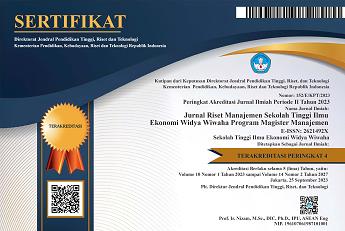ANALISIS KUALITAS LAYANAN HIGHER EDUCATION PERFORMANCE (HEedPERF) TERHADAP LOYALITAS MAHASISWA DI FAKULTAS 'X'
DOI:
https://doi.org/10.32477/jrm.v4i1.65Keywords:
HEdPERF, Loyalty Students, Regression, Classical Assumption TestAbstract
Education industry has been the subject of interest in the study, because the modern market today all companies and institutions are required to develop capacity and provide a flexible reaction to survive and develop capabilities advantage in the markets they serve. By understanding the variables of service quality and loyalty of students, not only can help educational organizations in managing its resources optimally as possible, but even more important is to maintain life so as to keep education, as well as building long-term relationships with their students.This study aims to determine the effect of variable HEdPERF (non-academics, academic, reputation, access, and programs offered) the loyalty of the students. The method used in the analysis of Multiple Linear Regression terms to meet Classical Assumption Test to test the hypothesis put forward. Based on the analysis and discussion of the five variables found that HEdPERF only three variables, namely the non-academic, reputation, and at that partially have an influence on student loyalty. While academic and access variables no significant effect on student loyalty. In addition, HEdPERF variables simultaneously affect the loyalty of students amounted to 23.9%, while the remaining 76.1% are other factors beyond the variables HEdPERF. The strong relationship HEdPERF variable loyalty for 52.8% of students can be quite strong. While HEdPERF variables that have most dominant influence on student loyalty program offered is a variable that is by by 8.22%.
References
Abdullah, F. (2006a), “Measuring Service Quality in Higher Education: HEdPERF Versus SERVPERF”, Marketing Intelligence & Planning, 24(1), 31–47, doi:10.1108/02634500610641543.
Abdullah, F. (2006b), “The Development of HEdPERF: A New Measuring Instrument of Service Quality for The Higher Education Sector”, International Journal of Consumer Studies, 30(6), 569–581, doi:10.1111/j.1470-6431.2005.00480.x.
Bei, L.-T. and Chiao, Y.-C. (2001), “An Integrated Model for The Effects of Perceived Product, Perceived Service Quality, and Perceived Prices Fairness on Consumer Satisfaction and Loyalty”, Journal of Consumer Satisfaction, Dissatisfaction and Complaining, 14, 125–140.
Brochado, A. (2009), “Comparing Alternative Instruments to Measure Service Quality in Higher Education”, Quality Assurance in Educatio n, 1 7(2), 17 4–19 0, doi:10.1108/09684880910951381.
Brown, R. M. and Mazzarol, T. W. (2008), “The Importance of Institutional Image to Student Satisfaction and Loyalty Within Higher Education”, Higher Education, 58(1), 81–95, doi:10.1007/ s10734-008-9183-8.
Calvo-Porral, C., Lévy-Mangin, J.-P. and Novo-Corti, I. (2013), “Perceived Quality in Higher Education: An Empirical Study”, Marketing Intelligence & Planning, 31(6), 601–619, doi:10.1108/MIP-11- 2012-0136.
Cronin, J. J. and Taylor, S. a. (1992), “Measuring Service Quality: A Reexamination and Extension”, Journal of Marketing, 56(3), 55–68, doi:10.2307/1252296.
Crosby, L. A., Evans, K. R. and Cowles, D. (1990), “Relationship Quality in Services Selling: An Interpersonal Influence Perspective”, Journal of Marketing, 54(3), 68–81, doi:10.2307/1251817.
Dedic, G. (2004 ), “Comp etit iven ess Through Quality A Services Marketing Perspective”, Business And Economics, 1694–1706.
Dimas, G. A. (2011), “Quality Issues in Higher Education: A Multicriteria Framework of Satisfaction Measures”, Creative Education, 02(03), 305–312, doi:10.4236/ce.2011.23042.
Fernandes, C., Ross, K. and Meraj, M. (2013), “Understanding Student Satisfaction and Loyalty in The UAE HE Sector”, International Journal of Educational Man ageme nt, 27(6), 613 –63 0, doi:10.1108/IJEM-07-2012-0082.
Ford, J. B., Joseph, M. and Joseph, B. (1999), “Importance-perf ormance Analysis as A Strategic Tool for Service Marketers: The Case of Service Quality Perceptions of Business Students in New Zealand and The USA. Journal of Services Marketing, 13(2), 171–186, doi:10.1108/08876049910266068.
Gronroos, C. (1988), “Service Quality: The Six Criteria Of Good Perceived Service”, Review Of Business, 9(3), 10–13.
Helgesen, Ø. and Nesset, E. (2007), “What accounts for students’ loyalty? Some Field Study Evidence”, International Journal of Educational Management, 21(2 ), 1 26– 143, doi:10 .110 8/ 09513540710729926.
Hennig-Thurau, T., Langer, M. F. and & Hansen, U. (2001), “Modeling and Managing Student Loyalty: An Approach Based on the Concept of Relationship Quality”, Journal of Service Research, 3(4), 331–344, d i:10.1177/109467050134006.
Johnson, M. D., Gustaffson, A., Andreassen, T. W., Lervik, L. and Cha, J. (2001), “The Evolution and Future of National Satisfaction Index Model”, Journal Of Economic Psychology, 22, 217–245.
Kotler.P and K. L. Keller. (2007), Manajemen Pemasaran, Edisi Kedua Belas, Jilid I, Ja karta: PT. Indeks Ke lomp ok Gramedia.
LeBlanc, G. and Nguyen, N. (1997), “Searching for Excellence in Business Education: An Exploratory Study of Customer Impressions of Service Quality”, International Journal of Educational Management, 11(2), 72–79, doi:10.1108/09513549710163961.
Lee-Kelley, L., Davies, S. and Kangis, P. (2002), “Service Quality for Customer Retention in The UK Steel Industry: Old Dogs and New Tricks?”, European Business Review, 14(4), 276–286, doi:10.1108/09555340210434465.
MacMillan, K., Money, K., Downing, S. and Hillenbrand, C. (2005), “Reputation in Relationships: Measuring Experiences, Emotions and Behaviors”, Corporate Reputation Review, 8(3), 214–232.
Mattsson, J. (1992), “A Service Quality Model Based on An Ideal Value Standard”, International Journal of Service Industry Management, 3(3), 18–33.
Owlia, M. S. and Aspinwall, E.M. (1996), “A Framework for the dimensions of quality in Higher Education”, Quality Assurance in Education, 4(2), 12–20. doi:10.1108/ 09684889610116012
Parasuraman, A., Zeithaml, V.A. and Berry, L.L. (1985), “A Conceptual Model of Service Quality and Its Implications for Future Research”, Journal of Marketing, (49), 41–50.
Ruyter, K. De., Wetzels, M. and Bloemer, J. (1998), “On The Relationship Betwen Perceived Service Quality, Service Loyalty and Switching Costs”, International Journal of Service Industry Man ageme nt, 9(5 ), 436 –45 3, doi:10.1108/09564239810238848
Selnes, F. (1993), “An Examination of The Effect of Product Performance on Brand Reputation, Satisfaction and Loyalty”, European Journal of Marketing, 27(9), 19–35.
Soteriou, A.C. and Stavrinides, Y. (2000), “An Internal Customer Service Quality Data Envelopment Analysis Model for Bank Branches”, International Journal of Bank Marketing, 18(5), 246–252.
Soutar, G. and McNeil, M. (1996), “Measuring Service Quality in A Tertiary Institution”, Journal of Educational Administration, 34 (1), 72– 82, do i:10 .110 8/ 09578239610107174.
Štimac, H. and Simic, M.L. (2012), “Competitiveness in Higher Education: A Nedd for Marketing Orientation and Service Quality”, Economics of Sociology, 5(2), 23–34.
Surprenant, C.F. and Solomon, M.R. (1987), “Predictability and Personalization in The Service Encounter”, Journal of Marketing, 51(2), 86–96, doi:10.2307/ 1251131.









